Corporate and Financial Accounting Analysis of Rio Tinto and BHP Billiton
VerifiedAdded on 2022/10/16
|12
|2765
|429
AI Summary
Contents Introduction 2 Part A 2 Items recorded under owner’ equity section 2 Movement of each item with reason 3 Items recorded under liability section 4 Movement of each item with reason 5 Advantages or disadvantages of each sources of fund 7 Part B 7 Conclusion 8 References 9 Introduction The objective of the report is to discuss the accounting trends present in the Australian companies Rio Tinto and BHP Billiton. Further, below mentioned report is segregated into two parts, the part A of the report highlight the details about recording equity and
Contribute Materials
Your contribution can guide someone’s learning journey. Share your
documents today.
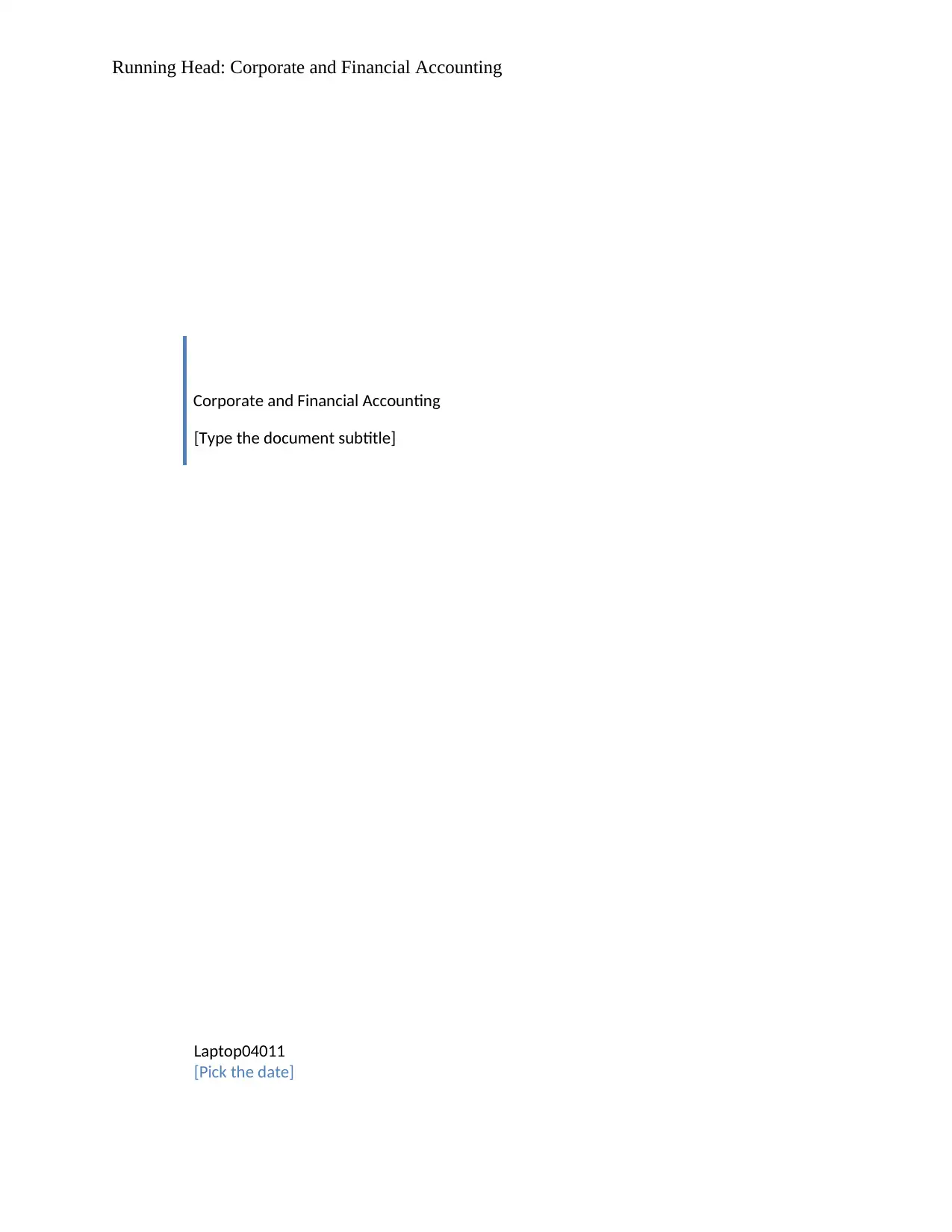
Running Head: Corporate and Financial Accounting
Corporate and Financial Accounting
[Type the document subtitle]
Laptop04011
[Pick the date]
Corporate and Financial Accounting
[Type the document subtitle]
Laptop04011
[Pick the date]
Secure Best Marks with AI Grader
Need help grading? Try our AI Grader for instant feedback on your assignments.
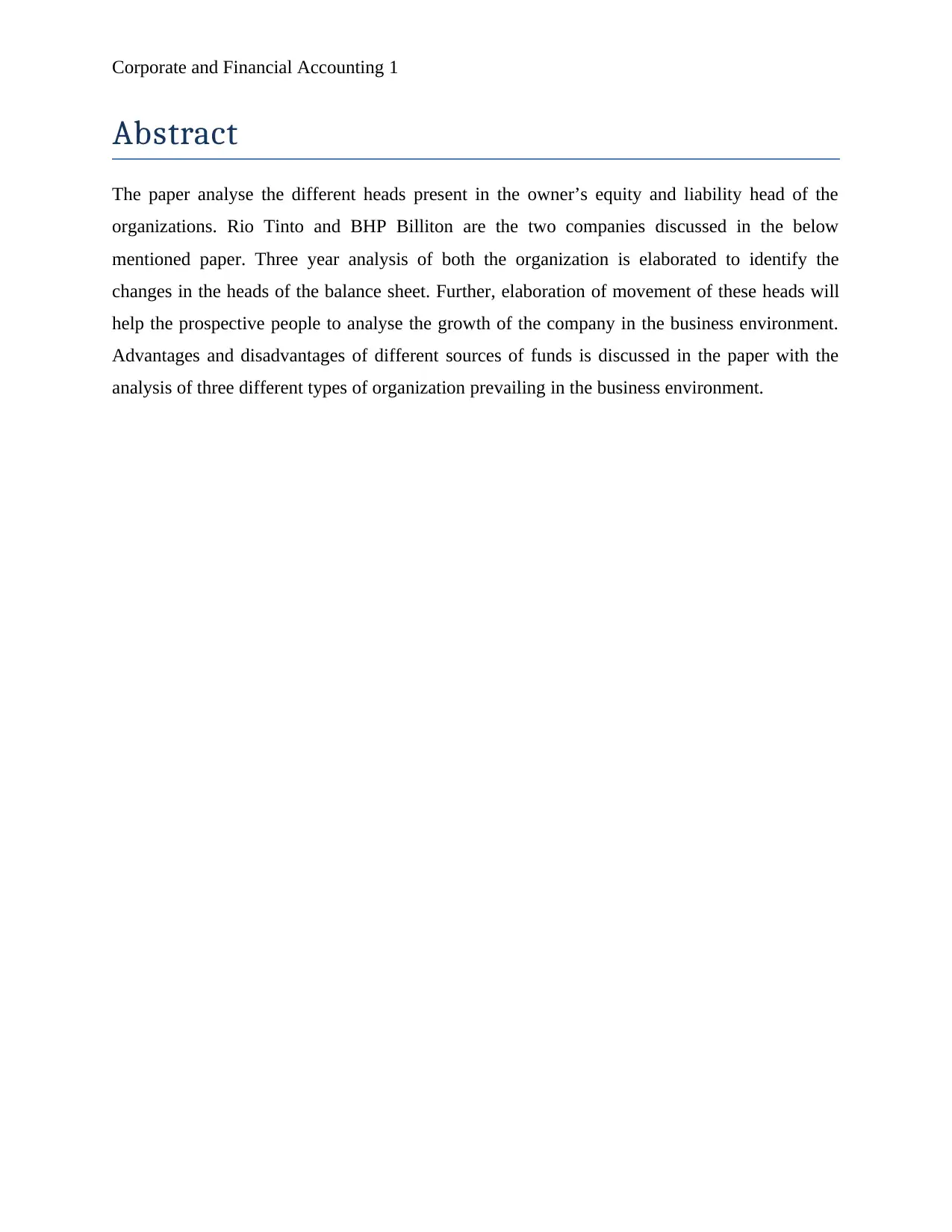
Corporate and Financial Accounting 1
Abstract
The paper analyse the different heads present in the owner’s equity and liability head of the
organizations. Rio Tinto and BHP Billiton are the two companies discussed in the below
mentioned paper. Three year analysis of both the organization is elaborated to identify the
changes in the heads of the balance sheet. Further, elaboration of movement of these heads will
help the prospective people to analyse the growth of the company in the business environment.
Advantages and disadvantages of different sources of funds is discussed in the paper with the
analysis of three different types of organization prevailing in the business environment.
Abstract
The paper analyse the different heads present in the owner’s equity and liability head of the
organizations. Rio Tinto and BHP Billiton are the two companies discussed in the below
mentioned paper. Three year analysis of both the organization is elaborated to identify the
changes in the heads of the balance sheet. Further, elaboration of movement of these heads will
help the prospective people to analyse the growth of the company in the business environment.
Advantages and disadvantages of different sources of funds is discussed in the paper with the
analysis of three different types of organization prevailing in the business environment.
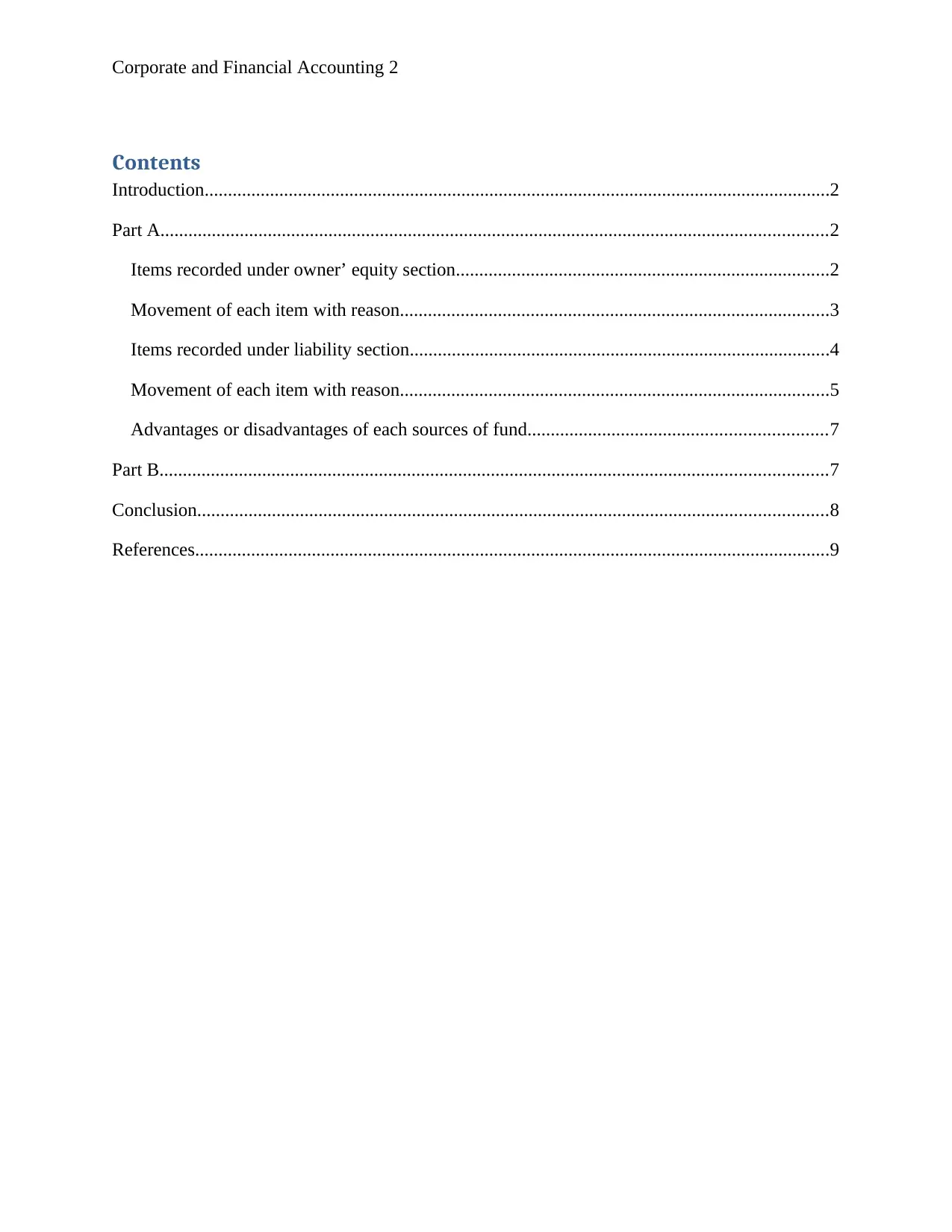
Corporate and Financial Accounting 2
Contents
Introduction......................................................................................................................................2
Part A...............................................................................................................................................2
Items recorded under owner’ equity section................................................................................2
Movement of each item with reason............................................................................................3
Items recorded under liability section..........................................................................................4
Movement of each item with reason............................................................................................5
Advantages or disadvantages of each sources of fund................................................................7
Part B...............................................................................................................................................7
Conclusion.......................................................................................................................................8
References........................................................................................................................................9
Contents
Introduction......................................................................................................................................2
Part A...............................................................................................................................................2
Items recorded under owner’ equity section................................................................................2
Movement of each item with reason............................................................................................3
Items recorded under liability section..........................................................................................4
Movement of each item with reason............................................................................................5
Advantages or disadvantages of each sources of fund................................................................7
Part B...............................................................................................................................................7
Conclusion.......................................................................................................................................8
References........................................................................................................................................9
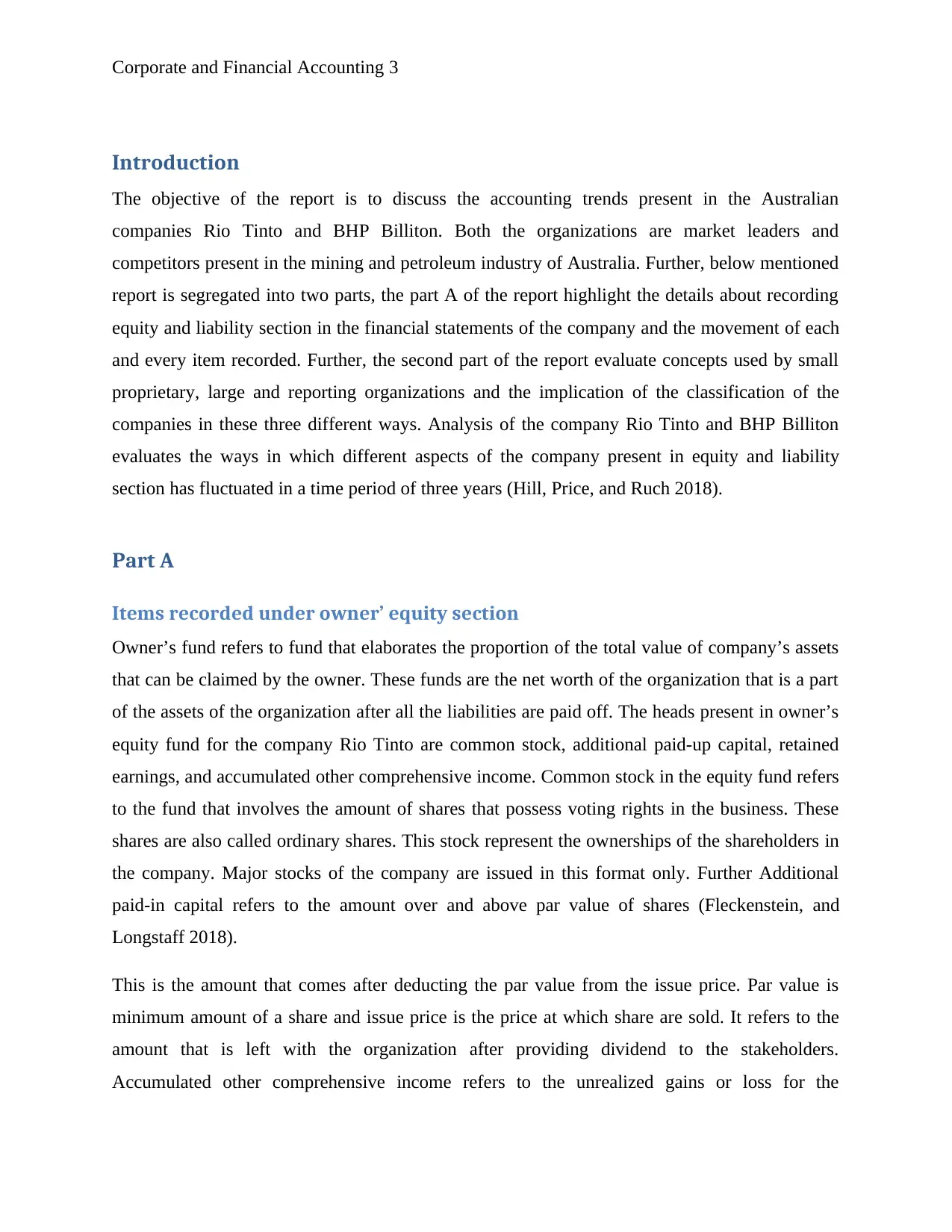
Corporate and Financial Accounting 3
Introduction
The objective of the report is to discuss the accounting trends present in the Australian
companies Rio Tinto and BHP Billiton. Both the organizations are market leaders and
competitors present in the mining and petroleum industry of Australia. Further, below mentioned
report is segregated into two parts, the part A of the report highlight the details about recording
equity and liability section in the financial statements of the company and the movement of each
and every item recorded. Further, the second part of the report evaluate concepts used by small
proprietary, large and reporting organizations and the implication of the classification of the
companies in these three different ways. Analysis of the company Rio Tinto and BHP Billiton
evaluates the ways in which different aspects of the company present in equity and liability
section has fluctuated in a time period of three years (Hill, Price, and Ruch 2018).
Part A
Items recorded under owner’ equity section
Owner’s fund refers to fund that elaborates the proportion of the total value of company’s assets
that can be claimed by the owner. These funds are the net worth of the organization that is a part
of the assets of the organization after all the liabilities are paid off. The heads present in owner’s
equity fund for the company Rio Tinto are common stock, additional paid-up capital, retained
earnings, and accumulated other comprehensive income. Common stock in the equity fund refers
to the fund that involves the amount of shares that possess voting rights in the business. These
shares are also called ordinary shares. This stock represent the ownerships of the shareholders in
the company. Major stocks of the company are issued in this format only. Further Additional
paid-in capital refers to the amount over and above par value of shares (Fleckenstein, and
Longstaff 2018).
This is the amount that comes after deducting the par value from the issue price. Par value is
minimum amount of a share and issue price is the price at which share are sold. It refers to the
amount that is left with the organization after providing dividend to the stakeholders.
Accumulated other comprehensive income refers to the unrealized gains or loss for the
Introduction
The objective of the report is to discuss the accounting trends present in the Australian
companies Rio Tinto and BHP Billiton. Both the organizations are market leaders and
competitors present in the mining and petroleum industry of Australia. Further, below mentioned
report is segregated into two parts, the part A of the report highlight the details about recording
equity and liability section in the financial statements of the company and the movement of each
and every item recorded. Further, the second part of the report evaluate concepts used by small
proprietary, large and reporting organizations and the implication of the classification of the
companies in these three different ways. Analysis of the company Rio Tinto and BHP Billiton
evaluates the ways in which different aspects of the company present in equity and liability
section has fluctuated in a time period of three years (Hill, Price, and Ruch 2018).
Part A
Items recorded under owner’ equity section
Owner’s fund refers to fund that elaborates the proportion of the total value of company’s assets
that can be claimed by the owner. These funds are the net worth of the organization that is a part
of the assets of the organization after all the liabilities are paid off. The heads present in owner’s
equity fund for the company Rio Tinto are common stock, additional paid-up capital, retained
earnings, and accumulated other comprehensive income. Common stock in the equity fund refers
to the fund that involves the amount of shares that possess voting rights in the business. These
shares are also called ordinary shares. This stock represent the ownerships of the shareholders in
the company. Major stocks of the company are issued in this format only. Further Additional
paid-in capital refers to the amount over and above par value of shares (Fleckenstein, and
Longstaff 2018).
This is the amount that comes after deducting the par value from the issue price. Par value is
minimum amount of a share and issue price is the price at which share are sold. It refers to the
amount that is left with the organization after providing dividend to the stakeholders.
Accumulated other comprehensive income refers to the unrealized gains or loss for the
Secure Best Marks with AI Grader
Need help grading? Try our AI Grader for instant feedback on your assignments.
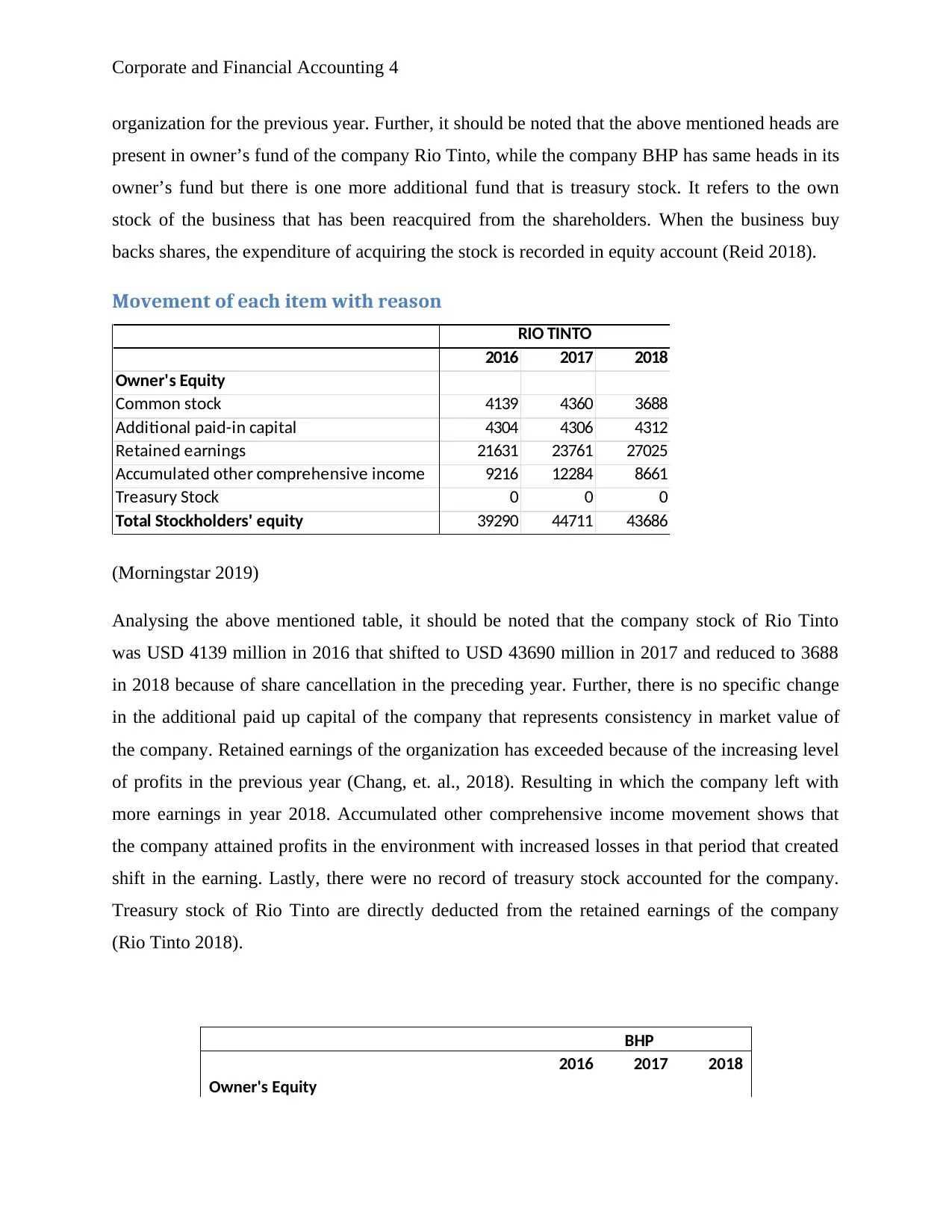
Corporate and Financial Accounting 4
organization for the previous year. Further, it should be noted that the above mentioned heads are
present in owner’s fund of the company Rio Tinto, while the company BHP has same heads in its
owner’s fund but there is one more additional fund that is treasury stock. It refers to the own
stock of the business that has been reacquired from the shareholders. When the business buy
backs shares, the expenditure of acquiring the stock is recorded in equity account (Reid 2018).
Movement of each item with reason
2016 2017 2018
Owner's Equity
Common stock 4139 4360 3688
Additional paid-in capital 4304 4306 4312
Retained earnings 21631 23761 27025
Accumulated other comprehensive income 9216 12284 8661
Treasury Stock 0 0 0
Total Stockholders' equity 39290 44711 43686
RIO TINTO
(Morningstar 2019)
Analysing the above mentioned table, it should be noted that the company stock of Rio Tinto
was USD 4139 million in 2016 that shifted to USD 43690 million in 2017 and reduced to 3688
in 2018 because of share cancellation in the preceding year. Further, there is no specific change
in the additional paid up capital of the company that represents consistency in market value of
the company. Retained earnings of the organization has exceeded because of the increasing level
of profits in the previous year (Chang, et. al., 2018). Resulting in which the company left with
more earnings in year 2018. Accumulated other comprehensive income movement shows that
the company attained profits in the environment with increased losses in that period that created
shift in the earning. Lastly, there were no record of treasury stock accounted for the company.
Treasury stock of Rio Tinto are directly deducted from the retained earnings of the company
(Rio Tinto 2018).
BHP
2016 2017 2018
Owner's Equity
organization for the previous year. Further, it should be noted that the above mentioned heads are
present in owner’s fund of the company Rio Tinto, while the company BHP has same heads in its
owner’s fund but there is one more additional fund that is treasury stock. It refers to the own
stock of the business that has been reacquired from the shareholders. When the business buy
backs shares, the expenditure of acquiring the stock is recorded in equity account (Reid 2018).
Movement of each item with reason
2016 2017 2018
Owner's Equity
Common stock 4139 4360 3688
Additional paid-in capital 4304 4306 4312
Retained earnings 21631 23761 27025
Accumulated other comprehensive income 9216 12284 8661
Treasury Stock 0 0 0
Total Stockholders' equity 39290 44711 43686
RIO TINTO
(Morningstar 2019)
Analysing the above mentioned table, it should be noted that the company stock of Rio Tinto
was USD 4139 million in 2016 that shifted to USD 43690 million in 2017 and reduced to 3688
in 2018 because of share cancellation in the preceding year. Further, there is no specific change
in the additional paid up capital of the company that represents consistency in market value of
the company. Retained earnings of the organization has exceeded because of the increasing level
of profits in the previous year (Chang, et. al., 2018). Resulting in which the company left with
more earnings in year 2018. Accumulated other comprehensive income movement shows that
the company attained profits in the environment with increased losses in that period that created
shift in the earning. Lastly, there were no record of treasury stock accounted for the company.
Treasury stock of Rio Tinto are directly deducted from the retained earnings of the company
(Rio Tinto 2018).
BHP
2016 2017 2018
Owner's Equity
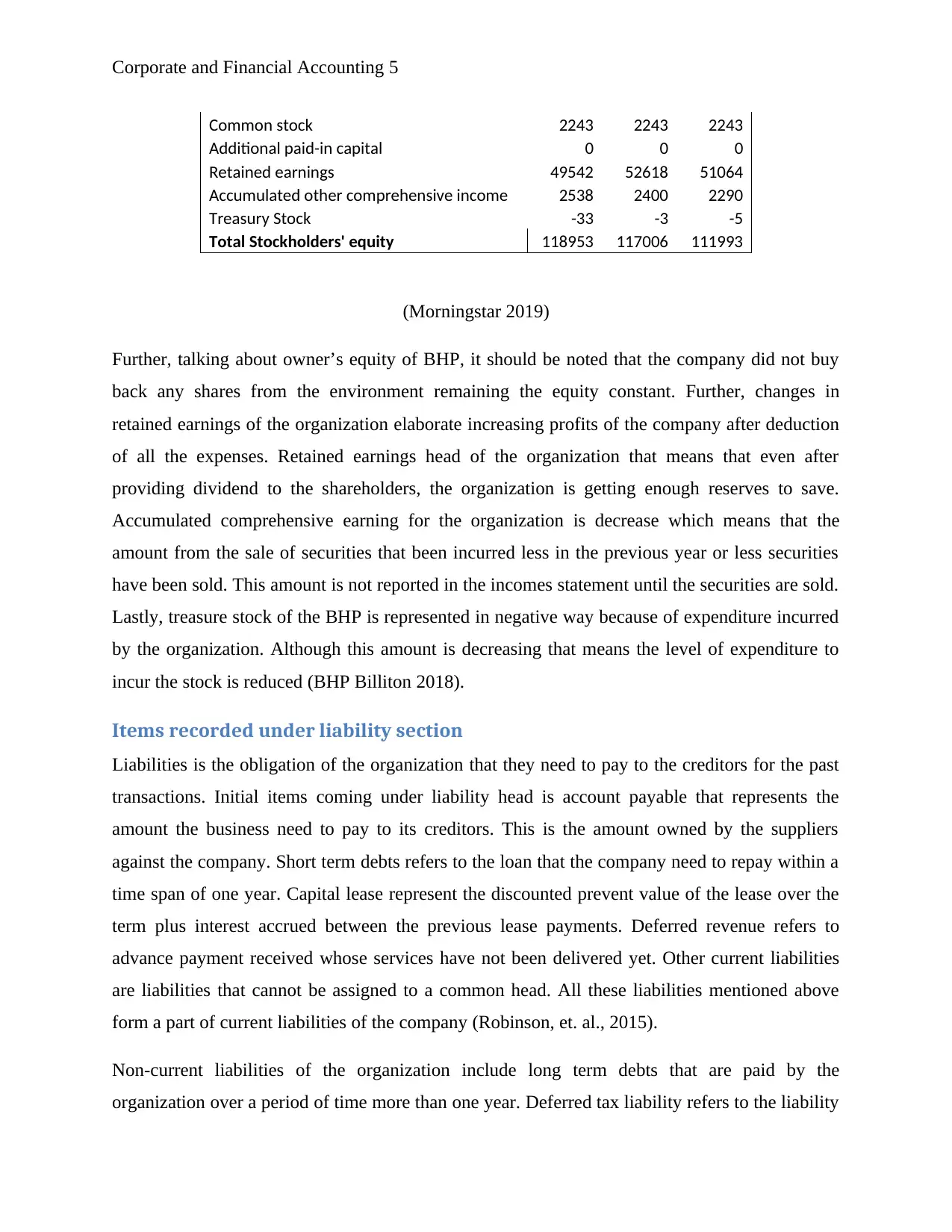
Corporate and Financial Accounting 5
Common stock 2243 2243 2243
Additional paid-in capital 0 0 0
Retained earnings 49542 52618 51064
Accumulated other comprehensive income 2538 2400 2290
Treasury Stock -33 -3 -5
Total Stockholders' equity 118953 117006 111993
(Morningstar 2019)
Further, talking about owner’s equity of BHP, it should be noted that the company did not buy
back any shares from the environment remaining the equity constant. Further, changes in
retained earnings of the organization elaborate increasing profits of the company after deduction
of all the expenses. Retained earnings head of the organization that means that even after
providing dividend to the shareholders, the organization is getting enough reserves to save.
Accumulated comprehensive earning for the organization is decrease which means that the
amount from the sale of securities that been incurred less in the previous year or less securities
have been sold. This amount is not reported in the incomes statement until the securities are sold.
Lastly, treasure stock of the BHP is represented in negative way because of expenditure incurred
by the organization. Although this amount is decreasing that means the level of expenditure to
incur the stock is reduced (BHP Billiton 2018).
Items recorded under liability section
Liabilities is the obligation of the organization that they need to pay to the creditors for the past
transactions. Initial items coming under liability head is account payable that represents the
amount the business need to pay to its creditors. This is the amount owned by the suppliers
against the company. Short term debts refers to the loan that the company need to repay within a
time span of one year. Capital lease represent the discounted prevent value of the lease over the
term plus interest accrued between the previous lease payments. Deferred revenue refers to
advance payment received whose services have not been delivered yet. Other current liabilities
are liabilities that cannot be assigned to a common head. All these liabilities mentioned above
form a part of current liabilities of the company (Robinson, et. al., 2015).
Non-current liabilities of the organization include long term debts that are paid by the
organization over a period of time more than one year. Deferred tax liability refers to the liability
Common stock 2243 2243 2243
Additional paid-in capital 0 0 0
Retained earnings 49542 52618 51064
Accumulated other comprehensive income 2538 2400 2290
Treasury Stock -33 -3 -5
Total Stockholders' equity 118953 117006 111993
(Morningstar 2019)
Further, talking about owner’s equity of BHP, it should be noted that the company did not buy
back any shares from the environment remaining the equity constant. Further, changes in
retained earnings of the organization elaborate increasing profits of the company after deduction
of all the expenses. Retained earnings head of the organization that means that even after
providing dividend to the shareholders, the organization is getting enough reserves to save.
Accumulated comprehensive earning for the organization is decrease which means that the
amount from the sale of securities that been incurred less in the previous year or less securities
have been sold. This amount is not reported in the incomes statement until the securities are sold.
Lastly, treasure stock of the BHP is represented in negative way because of expenditure incurred
by the organization. Although this amount is decreasing that means the level of expenditure to
incur the stock is reduced (BHP Billiton 2018).
Items recorded under liability section
Liabilities is the obligation of the organization that they need to pay to the creditors for the past
transactions. Initial items coming under liability head is account payable that represents the
amount the business need to pay to its creditors. This is the amount owned by the suppliers
against the company. Short term debts refers to the loan that the company need to repay within a
time span of one year. Capital lease represent the discounted prevent value of the lease over the
term plus interest accrued between the previous lease payments. Deferred revenue refers to
advance payment received whose services have not been delivered yet. Other current liabilities
are liabilities that cannot be assigned to a common head. All these liabilities mentioned above
form a part of current liabilities of the company (Robinson, et. al., 2015).
Non-current liabilities of the organization include long term debts that are paid by the
organization over a period of time more than one year. Deferred tax liability refers to the liability
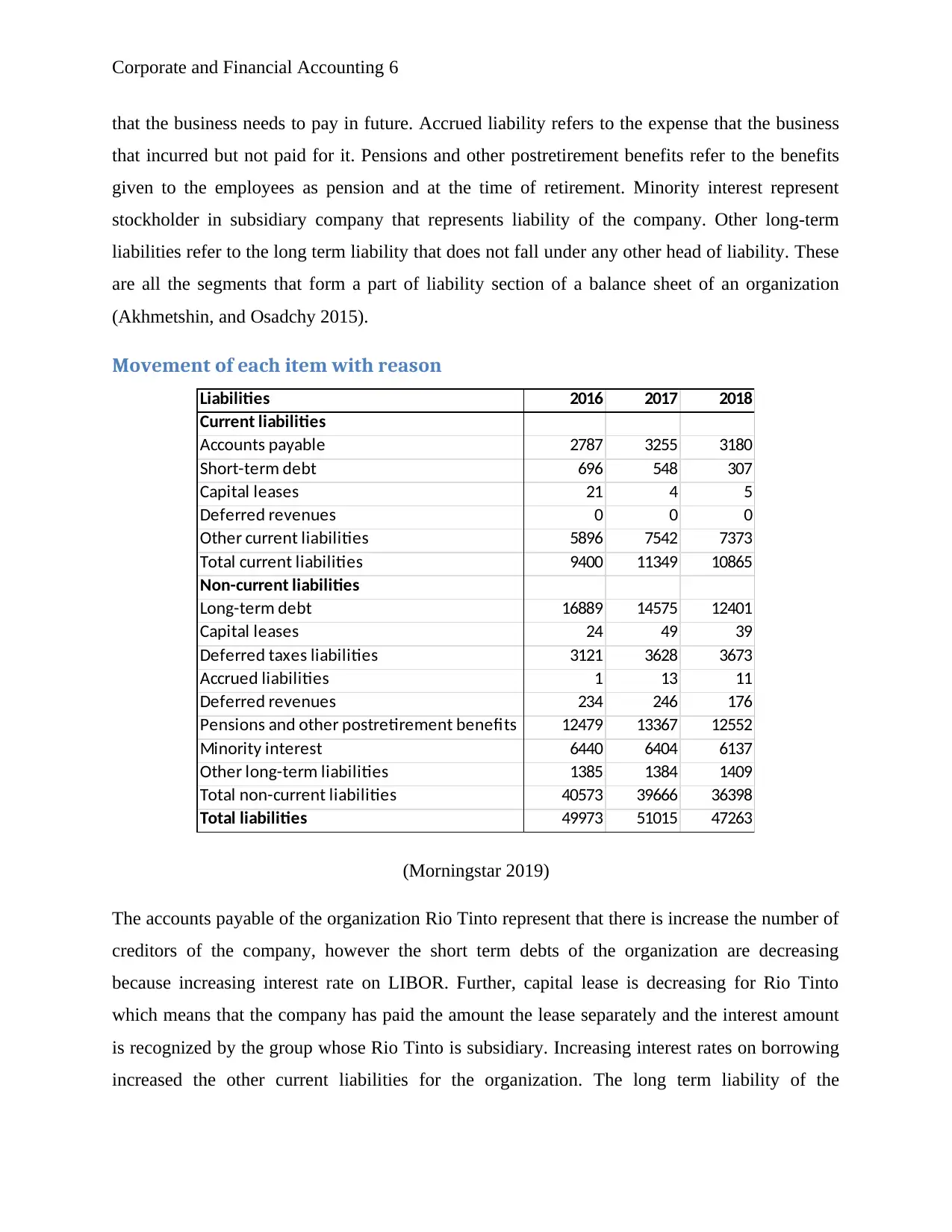
Corporate and Financial Accounting 6
that the business needs to pay in future. Accrued liability refers to the expense that the business
that incurred but not paid for it. Pensions and other postretirement benefits refer to the benefits
given to the employees as pension and at the time of retirement. Minority interest represent
stockholder in subsidiary company that represents liability of the company. Other long-term
liabilities refer to the long term liability that does not fall under any other head of liability. These
are all the segments that form a part of liability section of a balance sheet of an organization
(Akhmetshin, and Osadchy 2015).
Movement of each item with reason
Liabilities 2016 2017 2018
Current liabilities
Accounts payable 2787 3255 3180
Short-term debt 696 548 307
Capital leases 21 4 5
Deferred revenues 0 0 0
Other current liabilities 5896 7542 7373
Total current liabilities 9400 11349 10865
Non-current liabilities
Long-term debt 16889 14575 12401
Capital leases 24 49 39
Deferred taxes liabilities 3121 3628 3673
Accrued liabilities 1 13 11
Deferred revenues 234 246 176
Pensions and other postretirement benefits 12479 13367 12552
Minority interest 6440 6404 6137
Other long-term liabilities 1385 1384 1409
Total non-current liabilities 40573 39666 36398
Total liabilities 49973 51015 47263
(Morningstar 2019)
The accounts payable of the organization Rio Tinto represent that there is increase the number of
creditors of the company, however the short term debts of the organization are decreasing
because increasing interest rate on LIBOR. Further, capital lease is decreasing for Rio Tinto
which means that the company has paid the amount the lease separately and the interest amount
is recognized by the group whose Rio Tinto is subsidiary. Increasing interest rates on borrowing
increased the other current liabilities for the organization. The long term liability of the
that the business needs to pay in future. Accrued liability refers to the expense that the business
that incurred but not paid for it. Pensions and other postretirement benefits refer to the benefits
given to the employees as pension and at the time of retirement. Minority interest represent
stockholder in subsidiary company that represents liability of the company. Other long-term
liabilities refer to the long term liability that does not fall under any other head of liability. These
are all the segments that form a part of liability section of a balance sheet of an organization
(Akhmetshin, and Osadchy 2015).
Movement of each item with reason
Liabilities 2016 2017 2018
Current liabilities
Accounts payable 2787 3255 3180
Short-term debt 696 548 307
Capital leases 21 4 5
Deferred revenues 0 0 0
Other current liabilities 5896 7542 7373
Total current liabilities 9400 11349 10865
Non-current liabilities
Long-term debt 16889 14575 12401
Capital leases 24 49 39
Deferred taxes liabilities 3121 3628 3673
Accrued liabilities 1 13 11
Deferred revenues 234 246 176
Pensions and other postretirement benefits 12479 13367 12552
Minority interest 6440 6404 6137
Other long-term liabilities 1385 1384 1409
Total non-current liabilities 40573 39666 36398
Total liabilities 49973 51015 47263
(Morningstar 2019)
The accounts payable of the organization Rio Tinto represent that there is increase the number of
creditors of the company, however the short term debts of the organization are decreasing
because increasing interest rate on LIBOR. Further, capital lease is decreasing for Rio Tinto
which means that the company has paid the amount the lease separately and the interest amount
is recognized by the group whose Rio Tinto is subsidiary. Increasing interest rates on borrowing
increased the other current liabilities for the organization. The long term liability of the
Paraphrase This Document
Need a fresh take? Get an instant paraphrase of this document with our AI Paraphraser
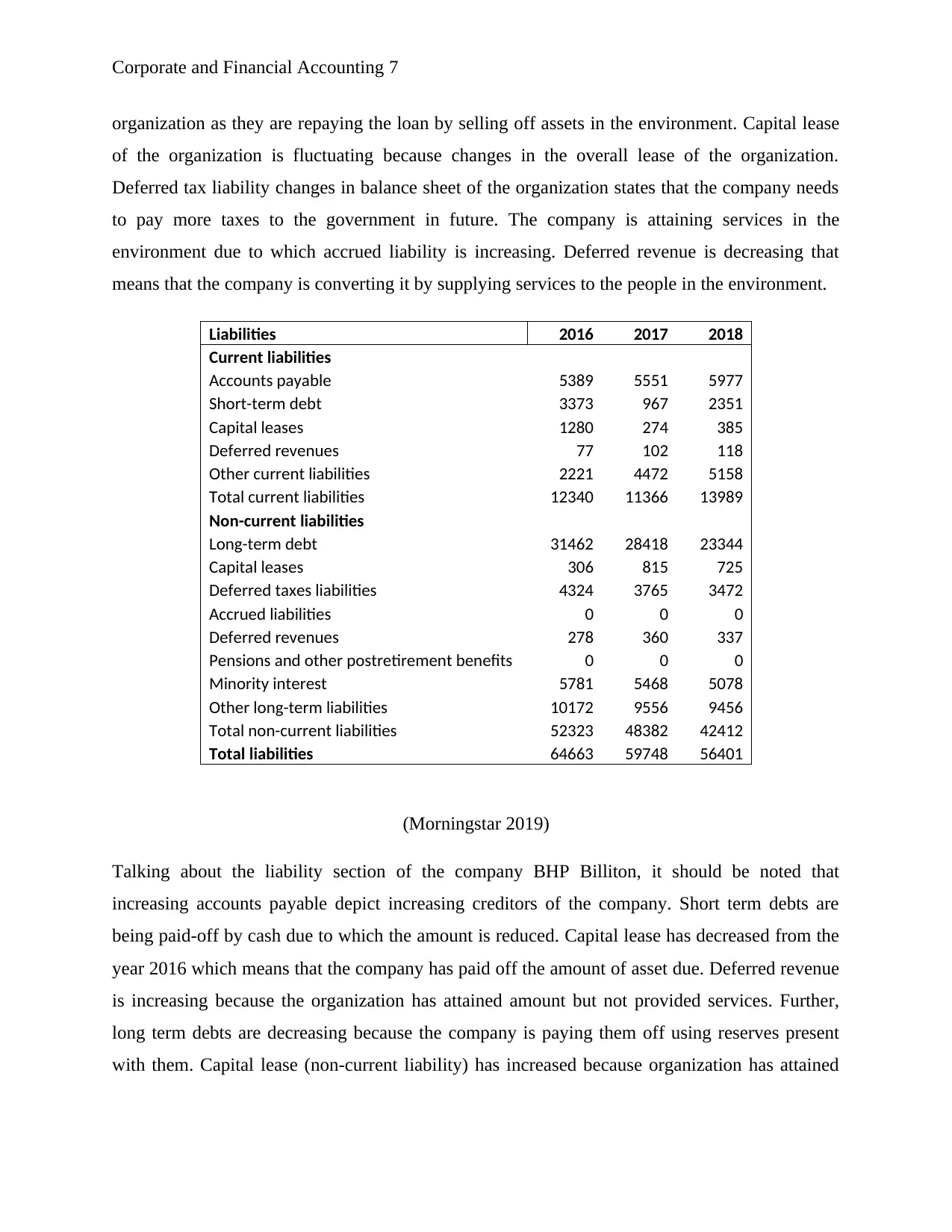
Corporate and Financial Accounting 7
organization as they are repaying the loan by selling off assets in the environment. Capital lease
of the organization is fluctuating because changes in the overall lease of the organization.
Deferred tax liability changes in balance sheet of the organization states that the company needs
to pay more taxes to the government in future. The company is attaining services in the
environment due to which accrued liability is increasing. Deferred revenue is decreasing that
means that the company is converting it by supplying services to the people in the environment.
Liabilities 2016 2017 2018
Current liabilities
Accounts payable 5389 5551 5977
Short-term debt 3373 967 2351
Capital leases 1280 274 385
Deferred revenues 77 102 118
Other current liabilities 2221 4472 5158
Total current liabilities 12340 11366 13989
Non-current liabilities
Long-term debt 31462 28418 23344
Capital leases 306 815 725
Deferred taxes liabilities 4324 3765 3472
Accrued liabilities 0 0 0
Deferred revenues 278 360 337
Pensions and other postretirement benefits 0 0 0
Minority interest 5781 5468 5078
Other long-term liabilities 10172 9556 9456
Total non-current liabilities 52323 48382 42412
Total liabilities 64663 59748 56401
(Morningstar 2019)
Talking about the liability section of the company BHP Billiton, it should be noted that
increasing accounts payable depict increasing creditors of the company. Short term debts are
being paid-off by cash due to which the amount is reduced. Capital lease has decreased from the
year 2016 which means that the company has paid off the amount of asset due. Deferred revenue
is increasing because the organization has attained amount but not provided services. Further,
long term debts are decreasing because the company is paying them off using reserves present
with them. Capital lease (non-current liability) has increased because organization has attained
organization as they are repaying the loan by selling off assets in the environment. Capital lease
of the organization is fluctuating because changes in the overall lease of the organization.
Deferred tax liability changes in balance sheet of the organization states that the company needs
to pay more taxes to the government in future. The company is attaining services in the
environment due to which accrued liability is increasing. Deferred revenue is decreasing that
means that the company is converting it by supplying services to the people in the environment.
Liabilities 2016 2017 2018
Current liabilities
Accounts payable 5389 5551 5977
Short-term debt 3373 967 2351
Capital leases 1280 274 385
Deferred revenues 77 102 118
Other current liabilities 2221 4472 5158
Total current liabilities 12340 11366 13989
Non-current liabilities
Long-term debt 31462 28418 23344
Capital leases 306 815 725
Deferred taxes liabilities 4324 3765 3472
Accrued liabilities 0 0 0
Deferred revenues 278 360 337
Pensions and other postretirement benefits 0 0 0
Minority interest 5781 5468 5078
Other long-term liabilities 10172 9556 9456
Total non-current liabilities 52323 48382 42412
Total liabilities 64663 59748 56401
(Morningstar 2019)
Talking about the liability section of the company BHP Billiton, it should be noted that
increasing accounts payable depict increasing creditors of the company. Short term debts are
being paid-off by cash due to which the amount is reduced. Capital lease has decreased from the
year 2016 which means that the company has paid off the amount of asset due. Deferred revenue
is increasing because the organization has attained amount but not provided services. Further,
long term debts are decreasing because the company is paying them off using reserves present
with them. Capital lease (non-current liability) has increased because organization has attained
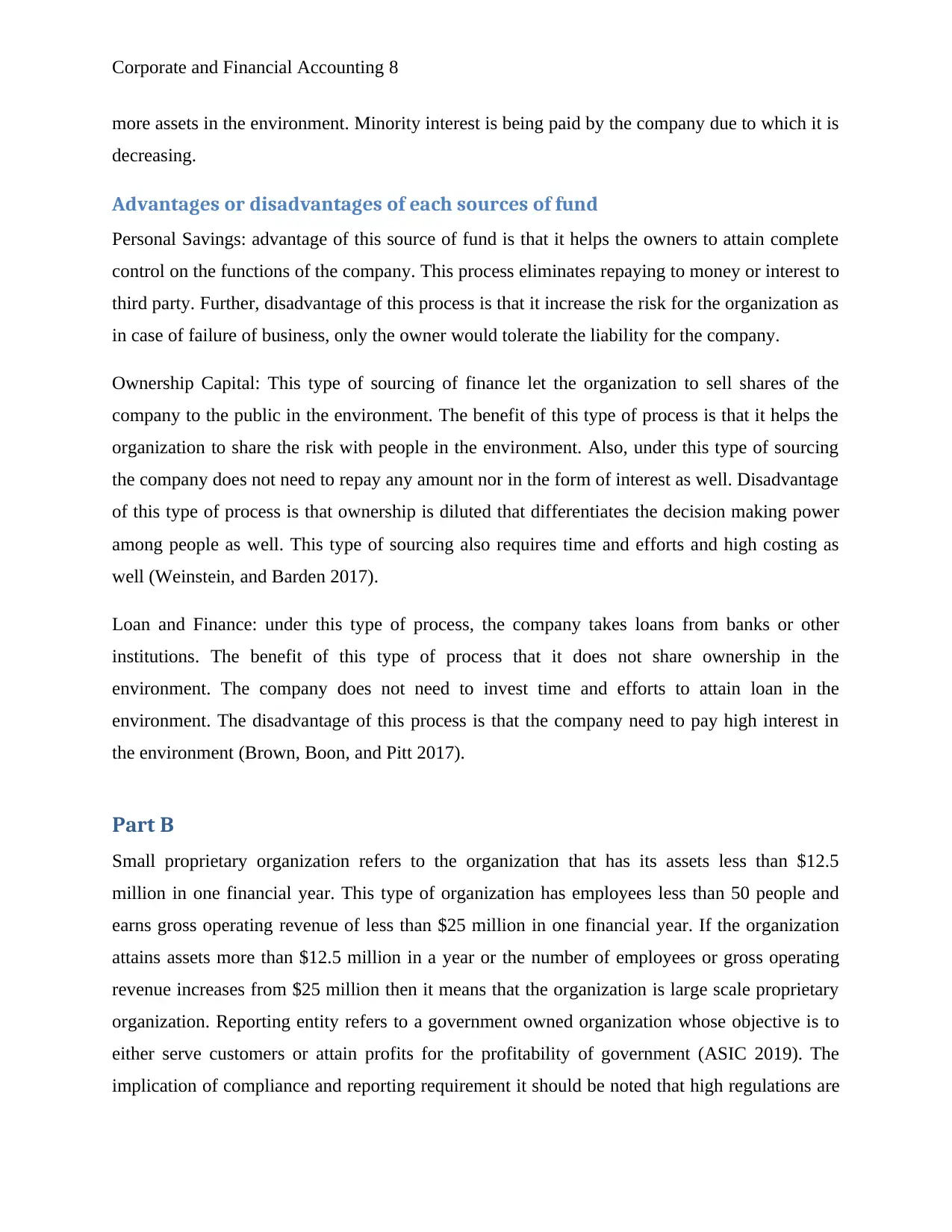
Corporate and Financial Accounting 8
more assets in the environment. Minority interest is being paid by the company due to which it is
decreasing.
Advantages or disadvantages of each sources of fund
Personal Savings: advantage of this source of fund is that it helps the owners to attain complete
control on the functions of the company. This process eliminates repaying to money or interest to
third party. Further, disadvantage of this process is that it increase the risk for the organization as
in case of failure of business, only the owner would tolerate the liability for the company.
Ownership Capital: This type of sourcing of finance let the organization to sell shares of the
company to the public in the environment. The benefit of this type of process is that it helps the
organization to share the risk with people in the environment. Also, under this type of sourcing
the company does not need to repay any amount nor in the form of interest as well. Disadvantage
of this type of process is that ownership is diluted that differentiates the decision making power
among people as well. This type of sourcing also requires time and efforts and high costing as
well (Weinstein, and Barden 2017).
Loan and Finance: under this type of process, the company takes loans from banks or other
institutions. The benefit of this type of process that it does not share ownership in the
environment. The company does not need to invest time and efforts to attain loan in the
environment. The disadvantage of this process is that the company need to pay high interest in
the environment (Brown, Boon, and Pitt 2017).
Part B
Small proprietary organization refers to the organization that has its assets less than $12.5
million in one financial year. This type of organization has employees less than 50 people and
earns gross operating revenue of less than $25 million in one financial year. If the organization
attains assets more than $12.5 million in a year or the number of employees or gross operating
revenue increases from $25 million then it means that the organization is large scale proprietary
organization. Reporting entity refers to a government owned organization whose objective is to
either serve customers or attain profits for the profitability of government (ASIC 2019). The
implication of compliance and reporting requirement it should be noted that high regulations are
more assets in the environment. Minority interest is being paid by the company due to which it is
decreasing.
Advantages or disadvantages of each sources of fund
Personal Savings: advantage of this source of fund is that it helps the owners to attain complete
control on the functions of the company. This process eliminates repaying to money or interest to
third party. Further, disadvantage of this process is that it increase the risk for the organization as
in case of failure of business, only the owner would tolerate the liability for the company.
Ownership Capital: This type of sourcing of finance let the organization to sell shares of the
company to the public in the environment. The benefit of this type of process is that it helps the
organization to share the risk with people in the environment. Also, under this type of sourcing
the company does not need to repay any amount nor in the form of interest as well. Disadvantage
of this type of process is that ownership is diluted that differentiates the decision making power
among people as well. This type of sourcing also requires time and efforts and high costing as
well (Weinstein, and Barden 2017).
Loan and Finance: under this type of process, the company takes loans from banks or other
institutions. The benefit of this type of process that it does not share ownership in the
environment. The company does not need to invest time and efforts to attain loan in the
environment. The disadvantage of this process is that the company need to pay high interest in
the environment (Brown, Boon, and Pitt 2017).
Part B
Small proprietary organization refers to the organization that has its assets less than $12.5
million in one financial year. This type of organization has employees less than 50 people and
earns gross operating revenue of less than $25 million in one financial year. If the organization
attains assets more than $12.5 million in a year or the number of employees or gross operating
revenue increases from $25 million then it means that the organization is large scale proprietary
organization. Reporting entity refers to a government owned organization whose objective is to
either serve customers or attain profits for the profitability of government (ASIC 2019). The
implication of compliance and reporting requirement it should be noted that high regulations are
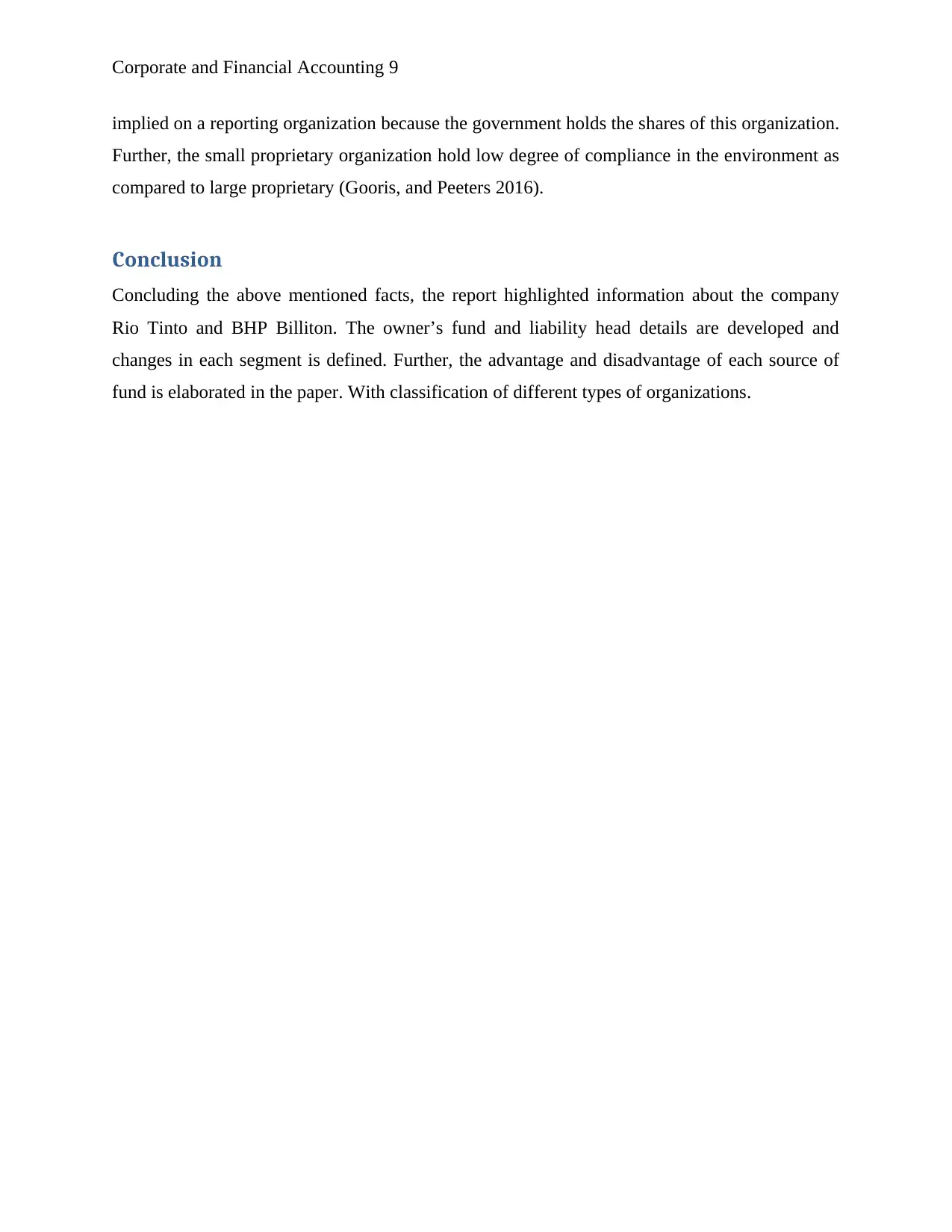
Corporate and Financial Accounting 9
implied on a reporting organization because the government holds the shares of this organization.
Further, the small proprietary organization hold low degree of compliance in the environment as
compared to large proprietary (Gooris, and Peeters 2016).
Conclusion
Concluding the above mentioned facts, the report highlighted information about the company
Rio Tinto and BHP Billiton. The owner’s fund and liability head details are developed and
changes in each segment is defined. Further, the advantage and disadvantage of each source of
fund is elaborated in the paper. With classification of different types of organizations.
implied on a reporting organization because the government holds the shares of this organization.
Further, the small proprietary organization hold low degree of compliance in the environment as
compared to large proprietary (Gooris, and Peeters 2016).
Conclusion
Concluding the above mentioned facts, the report highlighted information about the company
Rio Tinto and BHP Billiton. The owner’s fund and liability head details are developed and
changes in each segment is defined. Further, the advantage and disadvantage of each source of
fund is elaborated in the paper. With classification of different types of organizations.
Secure Best Marks with AI Grader
Need help grading? Try our AI Grader for instant feedback on your assignments.
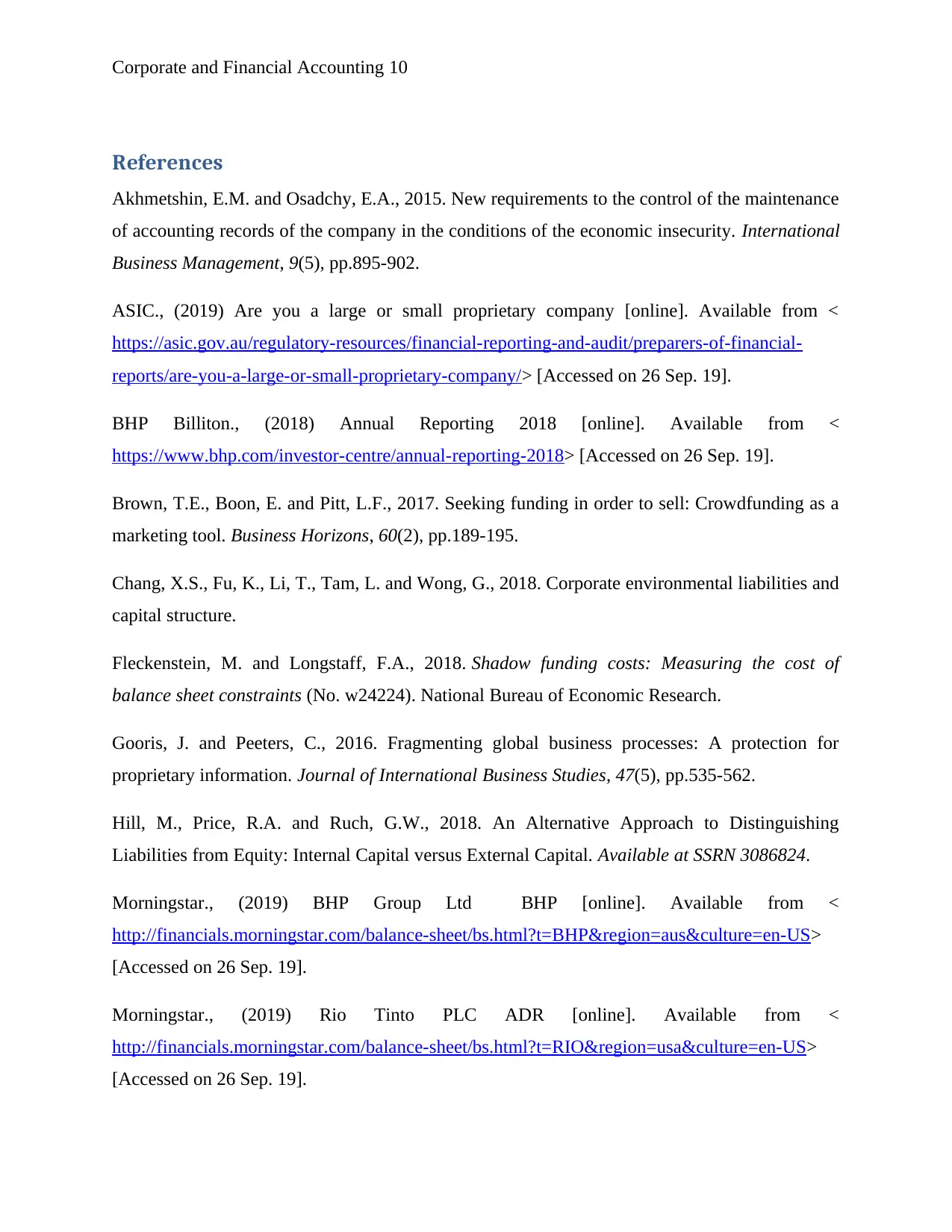
Corporate and Financial Accounting 10
References
Akhmetshin, E.M. and Osadchy, E.A., 2015. New requirements to the control of the maintenance
of accounting records of the company in the conditions of the economic insecurity. International
Business Management, 9(5), pp.895-902.
ASIC., (2019) Are you a large or small proprietary company [online]. Available from <
https://asic.gov.au/regulatory-resources/financial-reporting-and-audit/preparers-of-financial-
reports/are-you-a-large-or-small-proprietary-company/> [Accessed on 26 Sep. 19].
BHP Billiton., (2018) Annual Reporting 2018 [online]. Available from <
https://www.bhp.com/investor-centre/annual-reporting-2018> [Accessed on 26 Sep. 19].
Brown, T.E., Boon, E. and Pitt, L.F., 2017. Seeking funding in order to sell: Crowdfunding as a
marketing tool. Business Horizons, 60(2), pp.189-195.
Chang, X.S., Fu, K., Li, T., Tam, L. and Wong, G., 2018. Corporate environmental liabilities and
capital structure.
Fleckenstein, M. and Longstaff, F.A., 2018. Shadow funding costs: Measuring the cost of
balance sheet constraints (No. w24224). National Bureau of Economic Research.
Gooris, J. and Peeters, C., 2016. Fragmenting global business processes: A protection for
proprietary information. Journal of International Business Studies, 47(5), pp.535-562.
Hill, M., Price, R.A. and Ruch, G.W., 2018. An Alternative Approach to Distinguishing
Liabilities from Equity: Internal Capital versus External Capital. Available at SSRN 3086824.
Morningstar., (2019) BHP Group Ltd BHP [online]. Available from <
http://financials.morningstar.com/balance-sheet/bs.html?t=BHP®ion=aus&culture=en-US>
[Accessed on 26 Sep. 19].
Morningstar., (2019) Rio Tinto PLC ADR [online]. Available from <
http://financials.morningstar.com/balance-sheet/bs.html?t=RIO®ion=usa&culture=en-US>
[Accessed on 26 Sep. 19].
References
Akhmetshin, E.M. and Osadchy, E.A., 2015. New requirements to the control of the maintenance
of accounting records of the company in the conditions of the economic insecurity. International
Business Management, 9(5), pp.895-902.
ASIC., (2019) Are you a large or small proprietary company [online]. Available from <
https://asic.gov.au/regulatory-resources/financial-reporting-and-audit/preparers-of-financial-
reports/are-you-a-large-or-small-proprietary-company/> [Accessed on 26 Sep. 19].
BHP Billiton., (2018) Annual Reporting 2018 [online]. Available from <
https://www.bhp.com/investor-centre/annual-reporting-2018> [Accessed on 26 Sep. 19].
Brown, T.E., Boon, E. and Pitt, L.F., 2017. Seeking funding in order to sell: Crowdfunding as a
marketing tool. Business Horizons, 60(2), pp.189-195.
Chang, X.S., Fu, K., Li, T., Tam, L. and Wong, G., 2018. Corporate environmental liabilities and
capital structure.
Fleckenstein, M. and Longstaff, F.A., 2018. Shadow funding costs: Measuring the cost of
balance sheet constraints (No. w24224). National Bureau of Economic Research.
Gooris, J. and Peeters, C., 2016. Fragmenting global business processes: A protection for
proprietary information. Journal of International Business Studies, 47(5), pp.535-562.
Hill, M., Price, R.A. and Ruch, G.W., 2018. An Alternative Approach to Distinguishing
Liabilities from Equity: Internal Capital versus External Capital. Available at SSRN 3086824.
Morningstar., (2019) BHP Group Ltd BHP [online]. Available from <
http://financials.morningstar.com/balance-sheet/bs.html?t=BHP®ion=aus&culture=en-US>
[Accessed on 26 Sep. 19].
Morningstar., (2019) Rio Tinto PLC ADR [online]. Available from <
http://financials.morningstar.com/balance-sheet/bs.html?t=RIO®ion=usa&culture=en-US>
[Accessed on 26 Sep. 19].
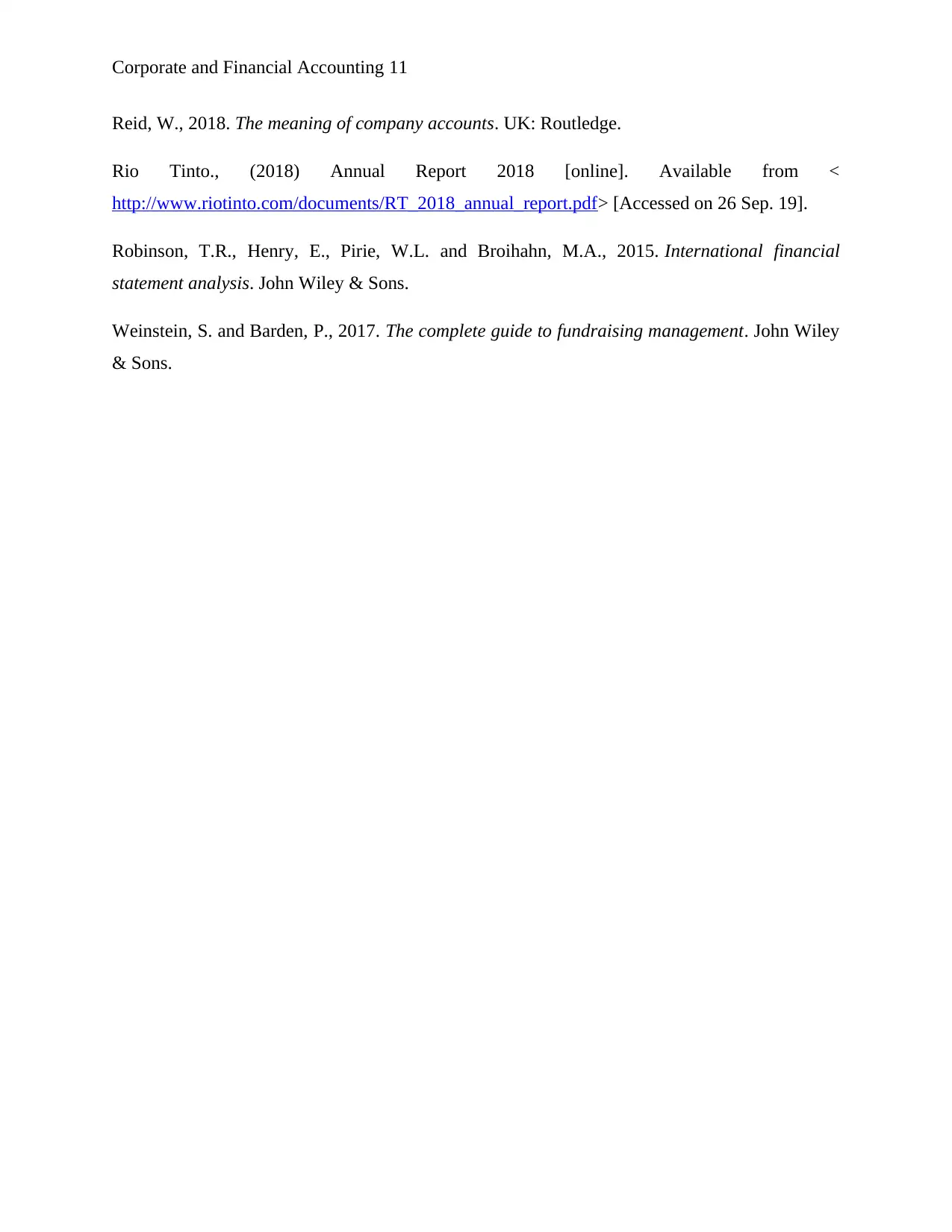
Corporate and Financial Accounting 11
Reid, W., 2018. The meaning of company accounts. UK: Routledge.
Rio Tinto., (2018) Annual Report 2018 [online]. Available from <
http://www.riotinto.com/documents/RT_2018_annual_report.pdf> [Accessed on 26 Sep. 19].
Robinson, T.R., Henry, E., Pirie, W.L. and Broihahn, M.A., 2015. International financial
statement analysis. John Wiley & Sons.
Weinstein, S. and Barden, P., 2017. The complete guide to fundraising management. John Wiley
& Sons.
Reid, W., 2018. The meaning of company accounts. UK: Routledge.
Rio Tinto., (2018) Annual Report 2018 [online]. Available from <
http://www.riotinto.com/documents/RT_2018_annual_report.pdf> [Accessed on 26 Sep. 19].
Robinson, T.R., Henry, E., Pirie, W.L. and Broihahn, M.A., 2015. International financial
statement analysis. John Wiley & Sons.
Weinstein, S. and Barden, P., 2017. The complete guide to fundraising management. John Wiley
& Sons.
1 out of 12
Related Documents
Your All-in-One AI-Powered Toolkit for Academic Success.
+13062052269
info@desklib.com
Available 24*7 on WhatsApp / Email
![[object Object]](/_next/static/media/star-bottom.7253800d.svg)
Unlock your academic potential
© 2024 | Zucol Services PVT LTD | All rights reserved.





